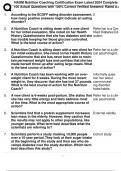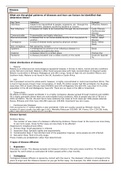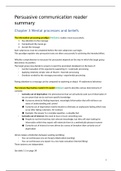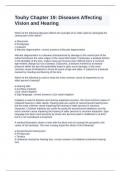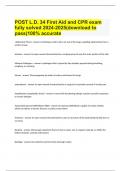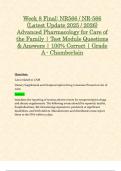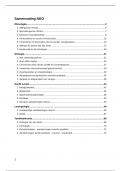PSYCHODIAGNOSTICS lecture 1
The history of psychological testing has relevance of how we are testing nowadays. The rudimentary
forms of psychological testing date back to ancient China. Officials of the Chinese emperor were
examined for their fitness for office. They were tested in 5 topics
- Civil law, military affairs, agriculture, revenue and geography
Between 384 and 322 before Christus, physiognomy became an important mainstream way of
assessing personality. Aristotle was an important person in this and stated that changes in a persons’
soul could impact on the appearance of the body.
1741-1801 Johann Lavater stated the character of personality of an individual could be judged from
details of facial appearance.
Phrenology refers to the notion of reading of bumps of the head to provide an index of mental
functions. Franz Joseph Gall (1810) was an important founder or phrenology. He believed that the
brain capacities are localized and the development of mental faculties is associated with enlargement
of the corresponding brain areas/ This enlargement of brain areas causes a bump on the head.
In 1800 the movement of phrenology moved to the US. In the late 1800s there was a movement
form introspective methods to objective procedures that were capable of replication. They devoted
specific attention to reaction time data and sensory information processing. The researchers made a
mistake, by thinking sensory processing measured intelligence.
Sir Francis Galton (1822-1911) can be considered the father of mental testing. He developed the first
data collection methods for many subjects which caused an onset of a large testing movement by
demonstrating objective assessment of individual differences.
A critique on this method was that intelligence could be better measured by higher mental processes
rather than elementary sensory processes such as reaction time. Together with Theodore Simon,
Binet developed the Simon-Binet Intelligence test (1905, 1908)
- Mainly developed for educational purposes and for the identification of children that
need special education
- 30 items ordered in level of difficulty
- Introduction of ‘mental age’
In 1916 the Stanford-Binet intelligence test was made and the concept of ‘Intelligence Quotient’ was
introduced. Later versions of the test provide a basis for quantative analysis of verbal vs. non-verbal
intelligence and other subcomponents of intelligence.
Development of other tests since 1900s
- Aptitude tests: index of clearly defined/specific ability used to predict succeed in
education
- Projective tests: index of unconscious motives, needs, emotions
- Personality tests: index of traits, qualities of behaviors. Predicting future behaviors
- Interest inventories: index of a preference for certain activities
, - Neuropsychological tests: index of a host of abilities to
determine the locus, extent, and behavioral
consequences of brain injury.
Psychodiagnostics is scientific research which makes use of an
‘empirical circle’
Step 1: assessment of clients complaints
Step 2: assessment of clients problems
Step 3: testing & diagnosing
Step 4: indication
There are some problems with
diagnostic classification systems, like a
lack of clear procedures to determine
a diagnosis, not well-defined criteria
and there either is a diagnosis or not.
A proper diagnosis conveys
information about strengths,
weaknesses, etiology and best choices for remediation and treatment.
PSYCHODIAGNOSTICS LECTURE 2
The intake is an important step in diagnosis. It is seen as the mist relevant and apricated skill of
psychologists
Role of the psychologist
- Provide a diagnosis in a limited time period
- Overview of background information
- Understand and formulate the case characteristics
- Therapeutic recommendations
The psychologist is always educating themselves, as diagnostic criteria can change over time but the
standard questions remain the same.
Goal of the intake
- Clarifying the request for help/the presenting complaint
- Insight into the origin
- Understanding of the problem
- Get to know the parents
- Preliminary development of assessment process
- Framework for interpretation of test results
- Building block for the client-therapist relationship
- Give insight into subsequent steps and procedures of the psychological investigation
- Agreement for treatment or referral
The intake has 7 important steps
1. Referral, presenting complaints, wishes and expectations
The history of psychological testing has relevance of how we are testing nowadays. The rudimentary
forms of psychological testing date back to ancient China. Officials of the Chinese emperor were
examined for their fitness for office. They were tested in 5 topics
- Civil law, military affairs, agriculture, revenue and geography
Between 384 and 322 before Christus, physiognomy became an important mainstream way of
assessing personality. Aristotle was an important person in this and stated that changes in a persons’
soul could impact on the appearance of the body.
1741-1801 Johann Lavater stated the character of personality of an individual could be judged from
details of facial appearance.
Phrenology refers to the notion of reading of bumps of the head to provide an index of mental
functions. Franz Joseph Gall (1810) was an important founder or phrenology. He believed that the
brain capacities are localized and the development of mental faculties is associated with enlargement
of the corresponding brain areas/ This enlargement of brain areas causes a bump on the head.
In 1800 the movement of phrenology moved to the US. In the late 1800s there was a movement
form introspective methods to objective procedures that were capable of replication. They devoted
specific attention to reaction time data and sensory information processing. The researchers made a
mistake, by thinking sensory processing measured intelligence.
Sir Francis Galton (1822-1911) can be considered the father of mental testing. He developed the first
data collection methods for many subjects which caused an onset of a large testing movement by
demonstrating objective assessment of individual differences.
A critique on this method was that intelligence could be better measured by higher mental processes
rather than elementary sensory processes such as reaction time. Together with Theodore Simon,
Binet developed the Simon-Binet Intelligence test (1905, 1908)
- Mainly developed for educational purposes and for the identification of children that
need special education
- 30 items ordered in level of difficulty
- Introduction of ‘mental age’
In 1916 the Stanford-Binet intelligence test was made and the concept of ‘Intelligence Quotient’ was
introduced. Later versions of the test provide a basis for quantative analysis of verbal vs. non-verbal
intelligence and other subcomponents of intelligence.
Development of other tests since 1900s
- Aptitude tests: index of clearly defined/specific ability used to predict succeed in
education
- Projective tests: index of unconscious motives, needs, emotions
- Personality tests: index of traits, qualities of behaviors. Predicting future behaviors
- Interest inventories: index of a preference for certain activities
, - Neuropsychological tests: index of a host of abilities to
determine the locus, extent, and behavioral
consequences of brain injury.
Psychodiagnostics is scientific research which makes use of an
‘empirical circle’
Step 1: assessment of clients complaints
Step 2: assessment of clients problems
Step 3: testing & diagnosing
Step 4: indication
There are some problems with
diagnostic classification systems, like a
lack of clear procedures to determine
a diagnosis, not well-defined criteria
and there either is a diagnosis or not.
A proper diagnosis conveys
information about strengths,
weaknesses, etiology and best choices for remediation and treatment.
PSYCHODIAGNOSTICS LECTURE 2
The intake is an important step in diagnosis. It is seen as the mist relevant and apricated skill of
psychologists
Role of the psychologist
- Provide a diagnosis in a limited time period
- Overview of background information
- Understand and formulate the case characteristics
- Therapeutic recommendations
The psychologist is always educating themselves, as diagnostic criteria can change over time but the
standard questions remain the same.
Goal of the intake
- Clarifying the request for help/the presenting complaint
- Insight into the origin
- Understanding of the problem
- Get to know the parents
- Preliminary development of assessment process
- Framework for interpretation of test results
- Building block for the client-therapist relationship
- Give insight into subsequent steps and procedures of the psychological investigation
- Agreement for treatment or referral
The intake has 7 important steps
1. Referral, presenting complaints, wishes and expectations

